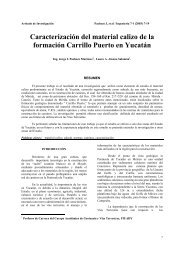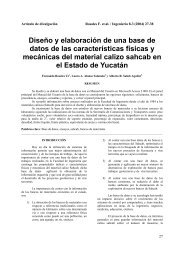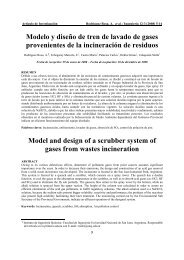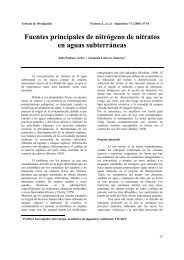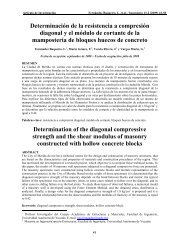Obtención de la ecuación de Euler-Lagrange utilizando los vectores ...
Obtención de la ecuación de Euler-Lagrange utilizando los vectores ...
Obtención de la ecuación de Euler-Lagrange utilizando los vectores ...
You also want an ePaper? Increase the reach of your titles
YUMPU automatically turns print PDFs into web optimized ePapers that Google loves.
Artículo <strong>de</strong> Investigación Acosta / Ingeniería 8-1 (2004) 17-22<br />
si multiplicamos ambos <strong>la</strong>dos <strong>de</strong> <strong>la</strong> igualdad por <strong>la</strong><br />
masa nos queda, en el <strong>la</strong>do izquierdo el momento<br />
generalizado y en el <strong>la</strong>do <strong>de</strong>recho <strong>la</strong> <strong>de</strong>rivada parcial<br />
<strong>de</strong> <strong>la</strong> energía cinética respecto <strong>de</strong> <strong>la</strong> velocidad<br />
generalizada:<br />
20<br />
∂ ⎛ 1 2 ⎞<br />
mvi<br />
= ⎜ mv ⎟ , (15)<br />
∂q&<br />
⎝ 2 ⎠<br />
i<br />
lo cual nos muestra una metodología <strong>de</strong> solución <strong>de</strong><br />
<strong>los</strong> problemas <strong>de</strong> mecánica en cualquier sistema <strong>de</strong><br />
coor<strong>de</strong>nadas, partiendo <strong>de</strong> una <strong>de</strong>scripción en<br />
coor<strong>de</strong>nadas cartesianas, ya que <strong>la</strong> magnitud <strong>de</strong> <strong>la</strong><br />
velocidad total es:<br />
r<br />
v<br />
&<br />
2 2 2<br />
= x + y + z ,<br />
&<br />
el método opera <strong>de</strong> <strong>la</strong> siguiente manera, se <strong>de</strong>scribe el<br />
movimiento <strong>de</strong> <strong>los</strong> objetos que interactúan en un<br />
momento t cualquiera a partir <strong>de</strong> sistema <strong>de</strong><br />
coor<strong>de</strong>nadas cartesianas fijo. Se <strong>de</strong>rivan <strong>la</strong>s<br />
componentes cartesianas respecto <strong>de</strong>l tiempo y<br />
finalmente <strong>la</strong> magnitud <strong>de</strong> <strong>la</strong> velocidad es <strong>la</strong> suma <strong>de</strong><br />
estas <strong>de</strong>rivadas elevadas al cuadrado. De esta<br />
<strong>de</strong>scripción se obtienen <strong>la</strong>s coor<strong>de</strong>nadas<br />
generalizadas, que serán <strong>los</strong> parámetros <strong>de</strong>l<br />
movimiento. Al multiplicar esta velocidad<br />
generalizada por <strong>la</strong> masa, nos quedan <strong>los</strong> momentos<br />
generalizados.<br />
Si modificamos <strong>la</strong> ec. (5), insertando el<br />
factor <strong>de</strong> esca<strong>la</strong>, <strong>de</strong>ntro <strong>de</strong>l paréntesis, se obtiene:<br />
∑= ⎟ ⎟<br />
r<br />
3 r ⎛ ⎞<br />
⎜<br />
r b r<br />
i<br />
v = v ⋅ b , (16)<br />
⎜ 2 i<br />
i 1 ⎝ hi<br />
⎠<br />
en <strong>la</strong> que el producto punto está ahora en función <strong>de</strong>l<br />
vector recíproco, el cual se conoce como <strong>la</strong><br />
componente contravariante <strong>de</strong>l vector velocidad, esta<br />
componente se representa por:<br />
v<br />
*<br />
i<br />
i<br />
&<br />
r r<br />
= v ⋅ c , (17)<br />
siguiendo el mismo procedimiento que en <strong>la</strong><br />
componente covariante, se obtiene:<br />
v<br />
*<br />
i<br />
∂qi<br />
∂qi<br />
∂qi<br />
= x&<br />
+ y&<br />
+ z&<br />
, (18)<br />
∂x<br />
∂y<br />
∂y<br />
escribiendo <strong>la</strong>s velocida<strong>de</strong>s en coor<strong>de</strong>nadas<br />
cartesianas, como <strong>de</strong>rivadas parciales:<br />
v<br />
*<br />
i<br />
∂x<br />
∂qi<br />
∂y<br />
∂qi<br />
∂z<br />
∂qi<br />
= + + , (19)<br />
∂t<br />
∂x<br />
∂t<br />
∂y<br />
∂t<br />
∂y<br />
se pue<strong>de</strong> ver que esto es so<strong>la</strong>mente <strong>la</strong> aplicación <strong>de</strong> <strong>la</strong><br />
reg<strong>la</strong> <strong>de</strong> <strong>la</strong> ca<strong>de</strong>na, por lo que se escribe como:<br />
v<br />
*<br />
i<br />
= q&<br />
, (20)<br />
es <strong>de</strong>cir que <strong>la</strong> componente contravariante <strong>de</strong> <strong>la</strong><br />
velocidad es <strong>la</strong> velocidad generalizada (Hausser,<br />
1969).<br />
4 Aceleraciones covariantes, contravariantes y<br />
fuerzas generalizadas<br />
De <strong>la</strong> misma manera que con <strong>la</strong> velocidad se<br />
obtienen <strong>la</strong>s componentes contravariante y covariante,<br />
obtenemos para <strong>la</strong> aceleración,<br />
a<br />
*<br />
i<br />
∂qi<br />
∂qi<br />
∂qi<br />
= &x<br />
& + &y<br />
& + &z<br />
& ,<br />
∂x<br />
∂y<br />
∂z<br />
en <strong>la</strong> que si tomamos el resultado <strong>de</strong> <strong>la</strong> ec. (11), se<br />
expresa como:<br />
x&<br />
q&<br />
i y&<br />
q&<br />
i z q&<br />
* ∂ ∂ ∂ ∂ ∂&<br />
∂ i<br />
ai<br />
= + + = q&<br />
&<br />
i ,<br />
∂t<br />
∂x&<br />
∂t<br />
∂y&<br />
∂t<br />
∂z&<br />
es <strong>de</strong>cir, <strong>la</strong> aceleración contravariante es igual a <strong>la</strong><br />
aceleración generalizada. Para <strong>la</strong> aceleración<br />
covariante se tiene:<br />
∂x<br />
∂y<br />
∂z<br />
ai<br />
= & x&<br />
+ &y<br />
& + &z<br />
& , (21)<br />
∂qi<br />
∂qi<br />
∂qi<br />
haciendo <strong>la</strong> <strong>de</strong>rivada respecto <strong>de</strong>l tiempo <strong>de</strong> <strong>la</strong><br />
coor<strong>de</strong>nada cartesiana x, y generalizando a <strong>la</strong>s otras<br />
coor<strong>de</strong>nadas.<br />
d<br />
dt<br />
i<br />
⎛ ∂x<br />
⎞ ∂x<br />
d ⎛ ∂x<br />
⎞<br />
⎜ x&<br />
⎟ = &x<br />
& + x&<br />
⎜<br />
⎟ , (22)<br />
⎝ ∂qi<br />
⎠ ∂qi<br />
dt ⎝ ∂qi<br />
⎠<br />
<strong>de</strong>spejando <strong>la</strong> ec. (22) y sustituyendo el resultado<br />
obtenido en <strong>la</strong> ec. (11), se obtiene:<br />
∂x<br />
d ⎛ ∂x&<br />
⎞ ∂x&<br />
& x&<br />
= x − x<br />
qi<br />
dt ⎜ &<br />
q ⎟ & . (23)<br />
∂ ⎝ ∂ &<br />
i ⎠ ∂qi



